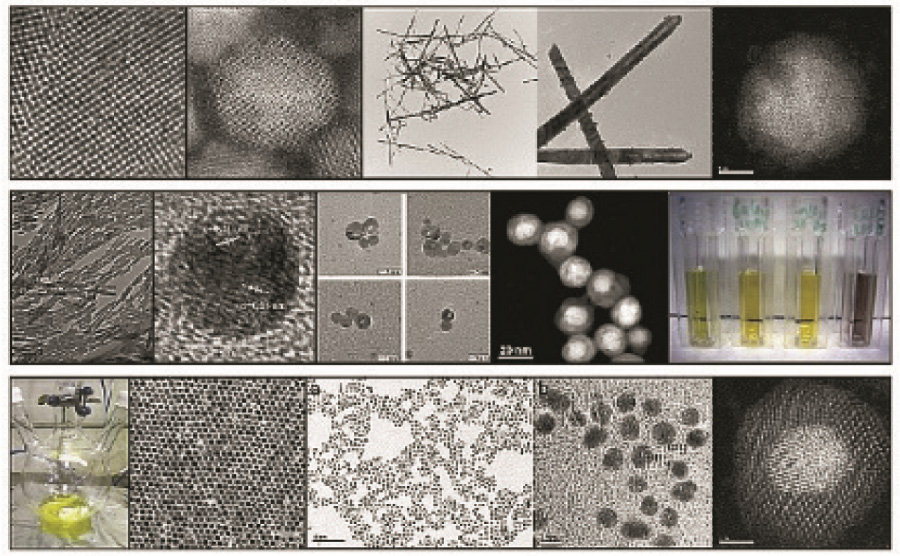
Nanoparticle Science and Technology From Synthesis to Applications
Laboratory on Nanoparticle Engineering
Professor:MAENOSONO Shinya
E-mail:
[Research areas]
Nanomaterials Chemistry; Colloid Chemistry
[Keywords]
quantum confinement effect; localized surface plasmon resonance; superparamagnetism; energy harvesting; nanomedicine; sensing
Skills and background we are looking for in prospective students
Basic academic skills, communication ability, broad intellectual curiosity, flexible thinking
What you can expect to learn in this laboratory
Nanoparticles have intermediate properties between atoms (molecules) and bulk crystals. We explore the frontiers of synthesis, higher-order structuring, and functionalization of nanoparticles. Our research in JAIST has focused on two main areas of interest in the field of materials chemistry and nanotechnology. The first area involved wet chemical synthesis of semiconductor nanoparticles with controlled size, shape and composition for energy conversion device applications. The second area has focused on the synthesis and biological application development of monometallic and alloyed multimetallic nanoparticles.
【Job category of graduates】
Industry (chemical industries, precision equipment manufacturers, electronics companies, glass and ceramics companies, textile industries, etc.) and academic research institutes (universities, national institutes, etc.)
Research outline

1. Thermoelectric nanoparticles
Thermoelectric materials have historically been an intriguing topic of materials science. In the global drive to develop sustainable energy, thermoelectric energy storage and generation technologies have attracted a tremendous interest. For practical applications, the dimensionless figure of merit, ZT=S2σT/κ (S: Seebeck coefficient, σ: electrical conductivity, κ: thermal conductivity, T: temperature) is required to be higher than ca. 2. Unfortunately, the existing thermoelectric materials have much lower ZT value because of the interdependence of σ and κ which defines the limitation in the ZT value. It has been widely recognized that the nanostructured thermoelectric materials with well-defined nanoscale grain boundaries can have reduced κ without much decrease in σ. With this in mind, we are working on synthesis of thermoelectric nanoparticles as promising building blocks for high-ZT nanostructured thermoelectric materials.
2. Metal nanoparticles
Metal nanoparticles have long been utilized for various types of chemical and/or biological sensing applications. At the same time, much of the knowledge being gained for manipulating nanoparticle structure or composition has focused on multimetallic nanoparticles. Such systems can display multiple properties arising from the individual components, but it is the observation of synergistic phenomena that is the most intriguing. By taking advantage of such synergistic phenomena, one can enhance the sensing properties when these multimetallic nanoparticles are used as sensing probes. We focus on the synthesis of novel multimetallic heterostructured nanoparticles and their applications including, but not limited to, biosensing probes, chemical sensors, and nanocatalysts.
3. Magnetic nanoparticles
Magnetic nanoparticles show great potential for various bio-medical applications from diagnosis to therapy. Multifunctional heterostructured magnetic nanoparticles are quite interesting materials from fundamental and practical point of view. This class of hybrid magnetic nanoparticles include magnetic-fluorescent and magnetic-plasmonic bifunctional nanoparticles. Those bifunctional nanoparticles can offer new opportunities for biomedical applications. In our research, we synthesize magnetic nanoparticles, and then their surfaces are coated with semiconductor or plasmonic materials. For example, we created FePt@CdSe core@shell bifunctional nanoparticles which have magnetic and fluorescent properties stemming from FePt core and CdSe shell, respectively. In another case, we have synthesized Ag@FeCo@Ag double-shell bifunctional nanoparticles which combine magnetic and plasmonic properties. Those bifunctional nanoparticles can be used in wide range of biomedical applications.
Key recent publications
- T. S. Le, M. Takahashi, N. Isozumi, A. Miyazato, Y. Hiratsuka, K. Matsumura, T. Taguchi, and S. Maenosono, “Quick and Mild Isolation of Intact Lysosomes Using Magnetic-Plasmonic Hybrid Nanoparticles”, ACS Nano 16 (2022) 885
- J. Hao, B. Liu, S. Maenosono, and J. Yang, “One-Pot Synthesis of Au-M@SiO2 (M = Rh, Pd, Ir, Pt) Core-Shell Nanoparticles as Highly Efficient Catalysts for the Reduction of 4-Nitrophenol”, Sci. Rep. 12 (2022) 7615
- T. S. Le, S. He, M. Takahashi, Y. Enomoto, Y. Matsumura, and S. Maenosono, “Enhancing the Sensitivity of Lateral Flow Immunoassay by Magnetic Enrichment Using Multifunctional Nanocomposite Probes”, Langmuir 37 (2021) 6566
Equipment
TEM, STEM, XRD, XPS, NMR, ICP-OES, SQUID, PPMS, DLS, UV-Vis, TGA, Raman, etc.
Teaching policy
For students who go on to work in industry soon after graduation, I will cultivate a comprehensive ability and give overall guidance to enable them to smoothly receive job offers. For students who want to pursue a PhD, I will provide a leading-edge and international research environment to enable them to find a career in academia.
[Website] URL:https://www.jaist.ac.jp/~shinya/